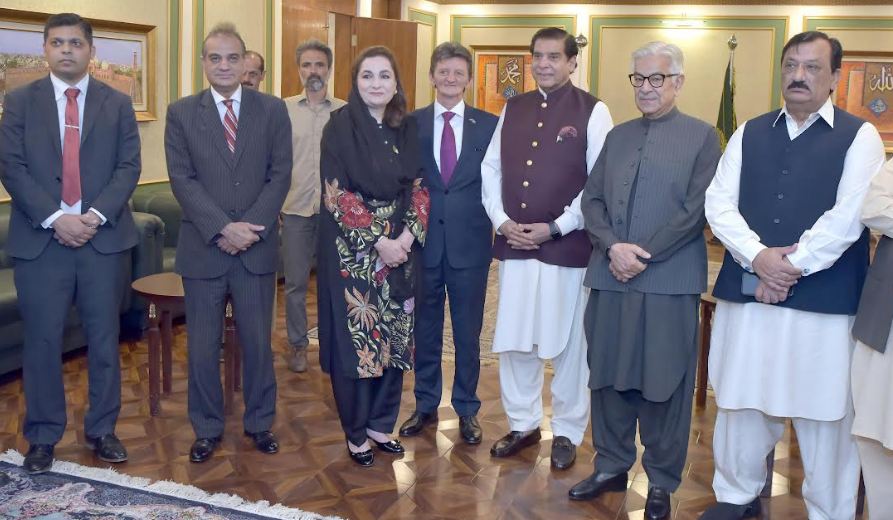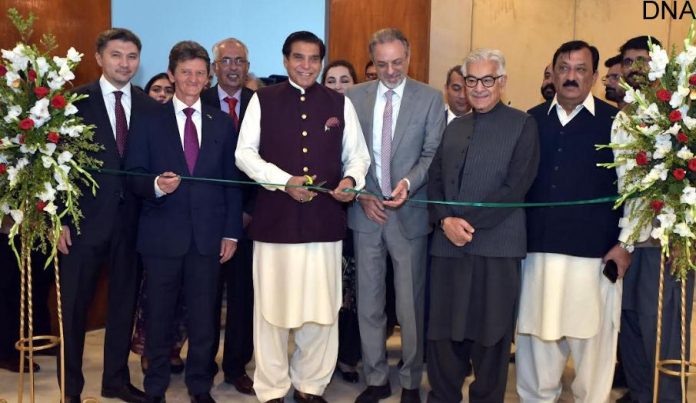Speaker National Assembly Raja Pervez Ashraf, Defence Minister Khawaja Asif, Mehnaz Aziz, Hungarian ambassador and others opened the exhibition
Ansar M Bhatti
ISLAMABAD: Speaker of the National Assembly Raja Pervez Ashraf inaugurated the exhibition titled Islamic Architectural Heritage in Hungary, at the Parliament House on Tuesday. The exhibition is first of its kind jointly organized by the Hungarian embassy in Islamabad and the National Assembly to mark the Golden Jubilee of the Constitution of Pakistan.
Defence Minister Khawaja Muhammad Asif, Mehnaz Akbar Aziz, Head of Pakistan-Hungary Parliamentarians group, Ambassadors, High Commissioners, former ministers and senators also attended the event. A large number of members of the civil society thronged to the event in order to enrich their knowledge of the Islamic Architectural Heritage of Hungary.

The Speaker National Assembly in his speech said Hungary became part of the Ottoman Empire in 1526 after Suleiman the Magnificent defeated the Hungarian Royal Army. It is just coincidence that it happened in the same year when Mugal emperor Babur invaded the northern part of the Subcontinent as a result of the first battle of Panipat.
He added Hungary was different from other parts of the Ottoman Empire not only for economic and social but for cultural reasons as well. In fact the Ottomans never succeeded in strengthening their power in Hungary during the 150 years of the occupation of the country.

Raja Pervez Ashraf declared relations between Pakistan and Hungary as excellent and hoped these relations would grow further even in the days to come. He thanked the Hungarian ambassador and the Embassy for arranging the exhibition. He hoped that both countries would be able to further expand cooperation in the field of culture and art as well.
Ambassador of Hungary Bela Fazekas in his speech said he was happy to co-host the important event along with the National Assembly secretariat. He hoped through the exhibition people would get information about the Islamic Architectural Heritage of Hungary.
The ambassador said although most buildings which were redesigned as mosques lost their Ottoman character after transforming them back into Christian churches, newly built mosques were conserved better. For example the Malkoc Beg Mosque at Sklos was renovated in the 1990s and subsequently won the Europa Nostra prize in 1993.
‘After the Yugoslav wars, when a small group of Muslims moved into the area the mosque once again began functioning. At Szigetvar where Suleiman the Magnificent died and the place where his organs were buried, was a popular Islamic pilgrimage site whose exact location was lost to time.’ he added.
Mehnaz Akbar Aziz, Head of Pakistan-Hungary Parliamentarians group in her speech thanked the Hungarian embassy for arranging the exhibition and thus providing the people to know about the Islamic architectural heritage of Hungary.
She added, Pakistan and Hungary enjoy excellent relations adding these relations were on the move. She thanked the Hungarian government for increasing the number of scholarships for Pakistani students from 200 to 400.
Mehnaz further said it was quite a unique experience for her to know about this aspect of Hungary. She said through this exhibition many Pakistanis would also get firsthand information. She also encouraged the Pakistanis to visit these sites as well when they go to Hungary to explore its natural grandeur.
Ambassador of Turkiye Mehmet Pacaci also spoke on the occasion and informed the audience about the analogies between Turkiye and Hungary’s Islamic heritage.
He said Ottoman architecture of Hungary or Majalistan, contained a mix of eastern and western elements as the Ottoman architects adapted to local buildings and materials. The Ottomans built many mosques in Hungary and incorporated many decorative elements in the surrounding areas. They also built castles and bridges in Hungary using their advanced architectural knowledge.

















